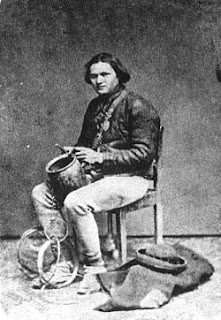The
following “singular” case appeared in the Morning Post in the
autumn of 1848 concerning a Biddulph Moor woman. On the 16th
September Doctor Bland ,a physician in the Macclesfield work house
was asked to attend a man dying from dysentery who lived in a lodge
house in the town. He thought that the man who was aged about 60
looked decidedly feminine around the face. The man named John Smith
also had a womanly voice. He spoke to Smith's wife who was with some
of her eleven children. She was not married to him, but had met him
14 years ago in New Mills, Derbyshire. Smith worked as an itinerant
knife grinder and spoon maker. His wife said that he was a supportive
husband. Some days later John Smith died and Bland returned to sign
the death certificate. His suspicions were correct and Smith was
female. His wife told the doctor that she had only found out the day
before Smith's death that he was male when he had her implored to sew
the body into a winding sheet. She told Bland that the 11 children
had been fathered by her first husband. “John Smith” was buried
in Christ Church and a great deal of interest was shown at the
funeral.
After
subsequent investigation Bland found that the dead woman had been
born Sophie Locke in a cave at Croker Wood, Sutton and moved to live
with her extended family who lived on Biddulph Moor. Sophie followed
her father's occupation as a tinker and knife grinder. The Lockes
were an itinerant lot and spent the year moving around the country,
although they always wintered on the moor. From an early age she
dressed as a male and often accompanied her brother around the pubs
in Biddulph and Congleton where the two would dance and play the
violin. She appeared to be a volatile soul and pretty handy with her
fists. Sophie got involved in a massive punch up at Bolton Green in
Lancashire and in the fight a breast was exposed. News of the
incident got back to Biddulph and the community impressively kept the
secret for the remainder of her life. Over the years whenever she
met someone from the town she became very wary and withdrew from
society although the concealment held. She rarely visited Biddulph
Moor after the Lockes were accused of sheep stealing.
She
lived as a husband to several women including one whom she married in
Winster Church in Derbyshire. The story is that a serving girl became
pregnant after a liaison with a local squire. Sophie was encouraged
to marry the woman and bring the child up as the “father” and
this relationship lasted some years. The woman that Doctor Bland met
had lived with Sophie for about 14 years and spent the year
travelling around the country with Locke and her large brood of
children. Taking part in the hop picking in Worcestershire every
autumn was something that the family enjoyed.
As I
said earlier Sophie gained enjoyment from challenging men to fight.
On one occasion at Bosley she was making a noise in a local pub. She
was defying a room full of men when in walked a hawker from Biddulph
that she knew. She exchanged compliments with the man and then left.
She
was described as being dark haired, of wiry build and very swarthy (
that sounds very “Saracen “ to me). The writer of the “Morning
Post article remarked “ that she would draw the attention of many
admirer of the gypsy picturesque”.







